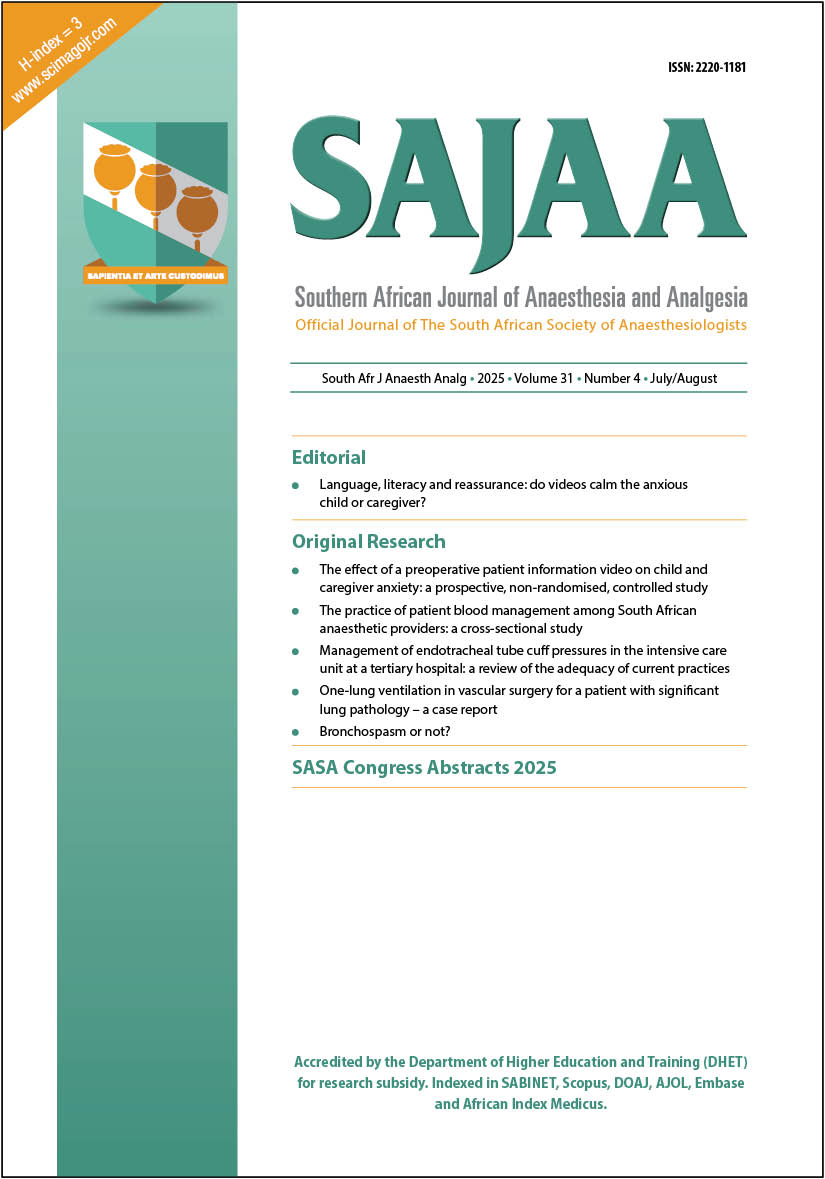The effect of a preoperative patient information video on child and caregiver anxiety: a prospective, non-randomised, controlled study
DOI:
https://doi.org/10.36303/SAJAA.3227Keywords:
modified Yale Preoperative Anxiety Scale, STAI-6, paediatric anxiety, parental anxiety, information videos, education videosAbstract
Background: Preoperative anxiety is common in paediatric patients and associated with significant adverse postoperative outcomes. Video techniques to alleviate preoperative anxiety are effective in adult patients, whilst there is variable evidence in children. In our setting, there is limited evidence demonstrating a similar impact on paediatric patients and their caregivers.
Methods: This was a prospective, non-randomised, controlled study to determine if exposure to a preoperative anaesthetic information video reduces anxiety levels in paediatric patients and their caregivers before surgery, compared to those who had routine preoperative counselling. A video was shown before the theatre, and a clip of the same video was shown pre-induction. Paediatric anxiety was assessed in the waiting area (T0) and at induction (T1) using the modified Yale Preoperative Anxiety Scale (mYPAS) for the child and the 6-point State-Trait Anxiety Inventory (STAI-6) for the caregiver.
Results: A total of 173 participants were included, 90 in the control group and 83 in the intervention group. The demographics of the groups were similar, except for the control group having younger patients (median [interquartile range, IQR], 6 [3–8] vs. intervention group 7 [5–9.75]; p = 0.03). Caregivers experienced a similar incidence of “high anxiety” in the control and intervention groups (59/90 [66%] vs. 61/83 [73%]; p = 0.52). There was no significant difference in median (IQR) STAI-6 scores between groups (control group 50.0 [43.4–53.5] and intervention group 50.0 [43.4–53.5]; p = 0.32). We also did not find a significant difference in the median (IQR) childhood anxiety measured by the mYPAS between groups at either T0 (39.6 [27.1–50.0] vs. 33.3 [22.9–45.8]; p = 0.107), or T1 (39.6 [33.3–53.6] vs. 39.6 [27.1–50.0]; p = 0.386).
Conclusion: A preoperative information video did not alter caregiver or child anxiety in our study. While we believe the video is an invaluable tool for education, consistent counselling, and information provision to patients in a familiar language, it does not demonstrably impact perioperative anxiety in our setting.
Downloads
Published
Issue
Section
License
Copyright (c) 2025 Author/s

This work is licensed under a Creative Commons Attribution-NonCommercial 4.0 International License.
By submitting manuscripts to SAJAA, authors of original articles are assigning copyright to the SA Society of Anaesthesiologists. Authors may use their own work after publication without written permission, provided they acknowledge the original source. Individuals and academic institutions may freely copy and distribute articles published in SAJAA for educational and research purposes without obtaining permission.
The work is licensed under a Creative Commons Attribution-Non-Commercial Works 4.0 South Africa License. The SAJAA does not hold itself responsible for statements made by the authors.

